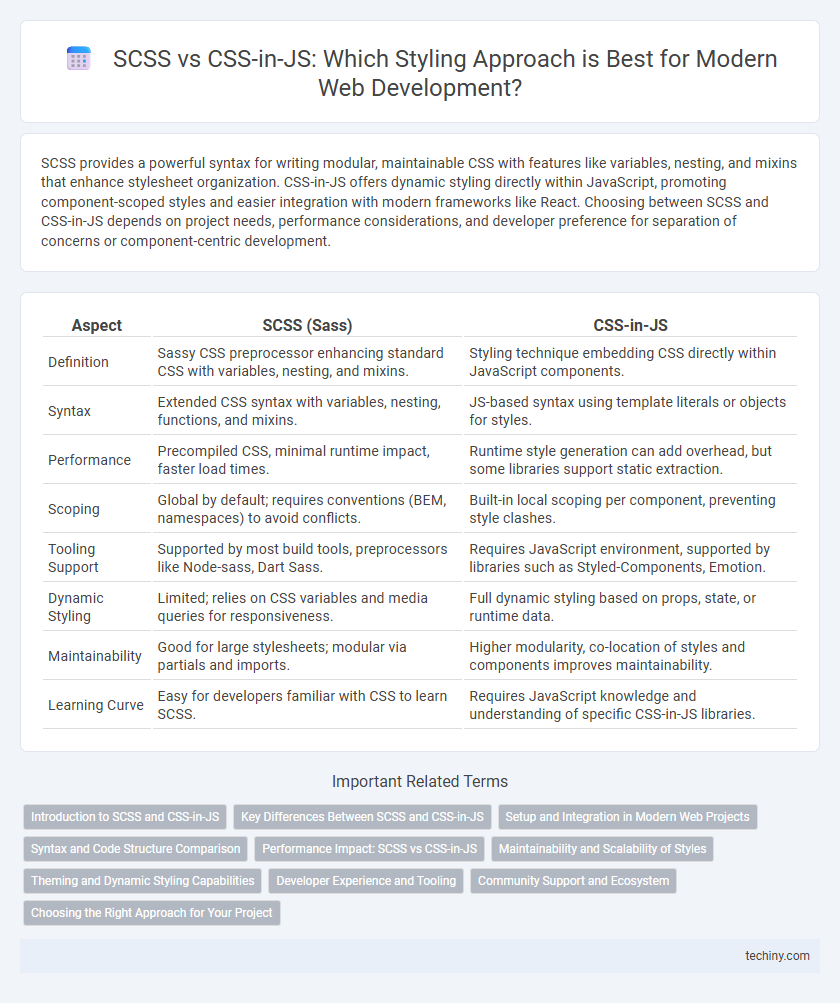SCSS provides a powerful syntax for writing modular, maintainable CSS with features like variables, nesting, and mixins that enhance stylesheet organization. CSS-in-JS offers dynamic styling directly within JavaScript, promoting component-scoped styles and easier integration with modern frameworks like React. Choosing between SCSS and CSS-in-JS depends on project needs, performance considerations, and developer preference for separation of concerns or component-centric development.
Table of Comparison
| Aspect | SCSS (Sass) | CSS-in-JS |
|---|---|---|
| Definition | Sassy CSS preprocessor enhancing standard CSS with variables, nesting, and mixins. | Styling technique embedding CSS directly within JavaScript components. |
| Syntax | Extended CSS syntax with variables, nesting, functions, and mixins. | JS-based syntax using template literals or objects for styles. |
| Performance | Precompiled CSS, minimal runtime impact, faster load times. | Runtime style generation can add overhead, but some libraries support static extraction. |
| Scoping | Global by default; requires conventions (BEM, namespaces) to avoid conflicts. | Built-in local scoping per component, preventing style clashes. |
| Tooling Support | Supported by most build tools, preprocessors like Node-sass, Dart Sass. | Requires JavaScript environment, supported by libraries such as Styled-Components, Emotion. |
| Dynamic Styling | Limited; relies on CSS variables and media queries for responsiveness. | Full dynamic styling based on props, state, or runtime data. |
| Maintainability | Good for large stylesheets; modular via partials and imports. | Higher modularity, co-location of styles and components improves maintainability. |
| Learning Curve | Easy for developers familiar with CSS to learn SCSS. | Requires JavaScript knowledge and understanding of specific CSS-in-JS libraries. |
Introduction to SCSS and CSS-in-JS
SCSS is a preprocessor scripting language that extends CSS by enabling variables, nested rules, and functions to create more maintainable and scalable stylesheets. CSS-in-JS integrates styling directly within JavaScript components, allowing dynamic and component-scoped styling for modern frameworks like React and Vue. Both SCSS and CSS-in-JS address CSS limitations, but SCSS enhances traditional CSS workflows while CSS-in-JS embraces the JavaScript ecosystem for better modularity and runtime styling.
Key Differences Between SCSS and CSS-in-JS
SCSS is a preprocessor that extends CSS with nested rules, variables, and mixins, enabling modular and reusable stylesheets compiled into standard CSS. CSS-in-JS integrates styling directly within JavaScript components, allowing dynamic styling, scoped styles, and leveraging runtime variables for enhanced interactivity. SCSS separates styles from logic, while CSS-in-JS tightly couples styles with component logic, impacting project structure and maintainability in web development.
Setup and Integration in Modern Web Projects
SCSS offers straightforward setup with native file support and seamless integration through build tools like Webpack or Sass CLI, enabling consistent styling workflows in modern web projects. CSS-in-JS requires additional configuration via libraries such as styled-components or Emotion, often involving Babel plugins and runtime dependencies, which can introduce complexity but enhance component-based styling. Both approaches support modularity, yet SCSS integrates well with existing CSS codebases while CSS-in-JS aligns tightly with JavaScript frameworks like React for dynamic styling capabilities.
Syntax and Code Structure Comparison
SCSS offers a traditional stylesheet syntax with nested rules, variables, and mixins that enhance CSS maintainability and readability. CSS-in-JS integrates styling directly within JavaScript components, enabling dynamic styling through JavaScript variables and functions while promoting scoped styles. The SCSS structure separates style definitions from component logic, whereas CSS-in-JS blends styles and behavior, improving modularity but increasing dependency on JavaScript runtime.
Performance Impact: SCSS vs CSS-in-JS
SCSS compiles into static CSS files that are cached by browsers, minimizing runtime overhead and enhancing page load speed, especially in large-scale applications. CSS-in-JS generates styles at runtime, which can introduce additional computation and memory usage, potentially affecting performance during rendering. Choosing SCSS benefits projects prioritizing initial load times and predictable performance, whereas CSS-in-JS suits dynamic styling needs with a trade-off in runtime efficiency.
Maintainability and Scalability of Styles
SCSS enhances maintainability through modular partials, clear nesting syntax, and reusable mixins, enabling organized and scalable style sheets in large projects. CSS-in-JS offers dynamic styling and scoped components, reducing global namespace conflicts and simplifying maintenance in component-driven frameworks like React. Choosing between SCSS and CSS-in-JS depends on project complexity, team familiarity, and scalability needs, with CSS-in-JS excelling in highly interactive applications and SCSS preferred for traditional, large-scale style management.
Theming and Dynamic Styling Capabilities
SCSS offers powerful theming through variables, mixins, and functions that enable reusable styles and maintainable design systems. CSS-in-JS frameworks like Styled Components and Emotion provide dynamic styling capabilities by leveraging JavaScript logic to apply styles conditionally and respond to runtime variables, enhancing component-level theming flexibility. This approach allows seamless integration of theme switching and dynamic style adjustments based on application state or user preferences.
Developer Experience and Tooling
SCSS offers a mature and feature-rich preprocessor environment with powerful nesting, variables, and mixins that enhance developer experience by enabling clean and maintainable stylesheets. CSS-in-JS provides seamless integration with JavaScript frameworks, real-time styling updates, and scoped styles, improving tooling through dynamic theming and component-level style encapsulation. Both approaches benefit from robust IDE support and debugging tools, but CSS-in-JS excels in environments requiring highly interactive or state-dependent style changes.
Community Support and Ecosystem
SCSS benefits from a mature, extensive community with decades of usage, offering a vast array of plugins, mixins, and frameworks that enhance styling capabilities. CSS-in-JS, while younger, is rapidly growing in ecosystem support, especially within React and modern JavaScript frameworks, providing dynamic styling solutions and strong integration with component-based architectures. Both approaches have vibrant communities, but SCSS's longevity offers more established resources, whereas CSS-in-JS caters better to modern JavaScript-driven development environments.
Choosing the Right Approach for Your Project
SCSS offers a powerful extension of CSS with features like variables, nesting, and mixins, making it ideal for large-scale projects requiring maintainable stylesheets and clear separation of concerns. CSS-in-JS enables dynamic styling by leveraging JavaScript's capabilities, providing scoped styles and component-based architecture suited for modern frameworks like React or Vue. Selecting between SCSS and CSS-in-JS depends on project size, team expertise, and the need for dynamic styling versus traditional stylesheet organization.
SCSS vs CSS-in-JS Infographic

 techiny.com
techiny.com